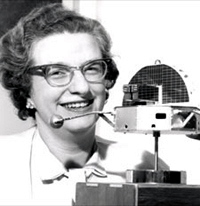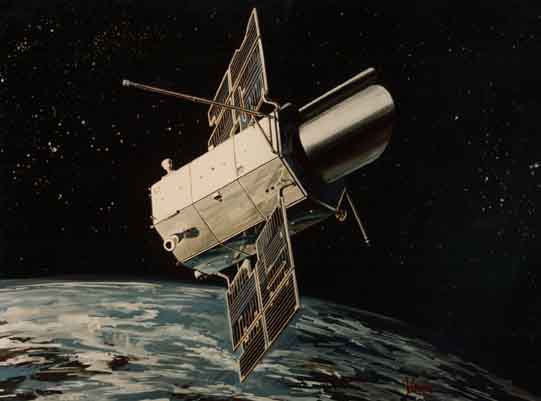
Nancy Roman with OSO model
credit: solarsystem.nasa.gov
Goddard Space Flight Center, Greenbelt, Maryland 20771
ENGINEERING COLLOQUIUM
Monday, April 27, 2009 / 3:30 PM, Building 3 Auditorium
Nancy Grace Roman
"Designing Astronomical Observatories for Space - Early Challenges"
ABSTRACT -- Because, the atmosphere presents several insurmountable problems for astronomical observations, astronomers were excited by the possibility of making observations from above this protective layer. The use of astronomical instruments on a remote, floating platform presented its own problems that took a couple of decades to resolve. Foremost of these were the ability to point an instrument in any direction and hold it accurately for many minutes and finding a satisfactory replacement for photographic film. Data storage and retrieval also presented a challenge to the technology of the early years of NASA.
SPEAKER -- Nancy Grace Roman graduated from Swarthmore College, then obtained a PhD from the University of Chicago, where she stayed on to continue her research in stellar astronomy with an emphasis on galactic structure. After leaving Chicago, she spent 3 years at the US Naval Research Laboratory in radio astronomy, then a new field in the US. There she mapped the sky at 67 cm. and worked with another person to refine the distance to the moon using radar. In early 1959, she joined NASA as head of the Optical Astronomy Program, becoming Chief of Astronomy the following year. She continued with various titles and the scientific responsibility for a program that gradually decreased in scope as it increased in content until early retirement in late 1979 as Chief of Astronomy and Relativity Programs. She continued to work for companies supporting NASA Goddard until October 1997.
Her duties while associated with NASA included a variety of activities on HST development, geodesy, earth resources, writing, and as head of the Astronomical Data Center.

Orbiting Astronomical Observatory.
Photo credit: history.nasa.gov
Missions on which she worked included:
- the Oribiting Solar Observatory (OSO) series,
- the Orbiting Astronomical Observatory (OAO) series,
- the International Ultraviolet Explorer (IUE),
- the Infra Red Astronomy Satellite (IRAS),
- the Cosmic Background Explorer (COBE).
Since leaving the space program, her main scientific activity has been teaching both children and adults, attending some of the many astronomical presentations in the area and recording astronomical textbooks for Reading for the Blind and Dyslexic.
Colloquium Committee Sponsor: Brent Warner
Engineering Colloquium home page: https://ecolloq.gsfc.nasa.gov